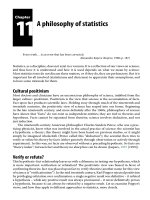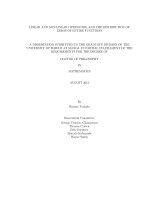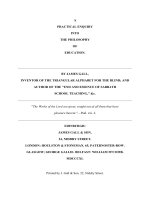Philosophy of mathematics
Bạn đang xem bản rút gọn của tài liệu. Xem và tải ngay bản đầy đủ của tài liệu tại đây (483.66 KB, 25 trang )
Philosophy of Mathematics
Efrah Ismael
Philosophy of Mathematics
5400
References
• Benacerraf, P., "Mathematical Truth", in The Philosophy
of Mathematics, Hart, W.D., (Ed.), (1996), Oxford
University Press, New York, p. 14-30.
• Coffa, J.A., The Semantic Tradition from Kant to Carnap:
To the Vienna Station, (1991), Cambridge University
Press, New York.
• Davis, P.J., & Hersh, R., The Mathematical Experience,
(1990), Penguin Books, Toronto.
• Hart, W.D., (Ed.), The Philosophy of Mathematics,
(1996), Oxford University Press, New York.
• Shapiro, Stewart, Philosophy of Mathematics: Structure
and Ontology, (2000), Oxford University Press
• Dieudonné characterizes the mathematician as
follows:
we believe in the reality of mathematics, but of
course when philosophers attack us with their
paradoxes we rush to hide behind formalism and
say "mathematics is just a combination of
meaningless symbols" . . . Finally we are left in
peace to go back to our mathematics, with the
feeling each mathematician has that he is
working on something real. (Dieudonné in Davis
and Hersh, [1981], p. 321)
• Davis and Hersh, also, describe mathematician
as:
• the typical mathematician is a [realist] on
weekdays and a formalist on Sundays. That is,
when he is doing mathematics he is convinced
that he is dealing with an objective reality . . . But
then, when challenged to give a philosophical
account of this reality, he finds it easiest to
pretend that he does not believe in it after all.
(Davis and Hersh, [1981], p.321)
• As Coffa notes,
• [t]he semantic tradition consisted of those who
believed in the a priori but not in the constitutive
powers of the mind . . . the root of all idealist
confusion lay in misunderstandings concerning
matters of meaning. Semanticists are easily
detected: They devote an uncommon amount of
attention to concepts, propositions, and senses .
. . (Coffa, [1991], p.1)
All these authors were questioning
• about what objects mentioned in
mathematical statements exist,
• about what mathematical statements we
can know,
• about what mathematical statements are
true or false.
mathematical practice and
philosophical theorizing
Stewart responds to the concern:
• ‘philosophy-first’
the principles of mathematics receive their
authority, if any, from philosophy. Because
we need a philosophical account of what
mathematics is about; only then can we
determine what qualifies as correct
mathematical reasoning.
‘philosophy-last’
• holds that mathematics is an autonomous
science that doesn’t need to borrow its
authority from other disciplines.
• On this view, philosophers have no right to
legislate mathematical practice but must
always accept mathematicians’ own
judgment.
What Place Does
Philosophy Have in
Teaching Mathematics?
What is Mathematics? B. Russell
Mathematics may be defined as the subject
in which we never know what we are talki
ng about, nor whether what we are saying
is true.
– Bertrand Russell, Mysticism and Logic
(1917) ch. 4
What is Philosophy of
Mathematics?
• Ontology for Mathematics: “Being”
• Ontology studies the nature of the objects of
mathematics.
• It is the claim that mathematical objects
exist independently of their linguistic
expression.
• “What we are talking about.”
–
–
–
–
What is a number?
What is a point? line?
What is a set?
In what sense do these objects exist?
What is Philosophy of
Mathematics?
• Epistemology for Mathematics: “Knowing”
• Epistemology studies the acquisition of
knowledge of the truth of a mathematical
statement.
“whether what we are saying is true.”
– Does knowledge come from experience and
evidence?
– Does knowledge come from argument and proof?
– Is knowledge relative or absolute?
Platonism
•
•
•
•
•
•
Platonism: is one of the main theories in the philosophy of mathematics,
and is one the major explanations of what mathematics really is.
The question it attempts to answer is whether mathematical truth has an
independent existence do:
mathematicians discover mathematical truths that are, in some sense, out
there to be found, or do they invent or create them?
The answer to this question will determine the very way in which
mathematician will look at his or her subject, and it is also part of the
question of whether mathematics is a science or an art, or even possibly a
game.
The Platonist position, based (as the name implies) on ideas in the works of
Plato, is that mathematical truth is discovered. The idea is that
mathematics consists of absolute truths, which were a prior (needing no
other foundation, but being inescapable consequences of logical
deduction).
This position was reiterated by Kant in the 18th century, particularly with
respect to Euclidean geometry.
What is Philosophy of
Mathematics?
According to Plato, knowledge is a subset of
that which is both true and believed
What is Philosophy of
Mathematics?
• Formalism / Deductivism• is a school of thought that all work in mathematics
should be reduced to manipulations of sentences of
symbolic logic, using standard rules.
• It was the logical outcome of the 19th-century search for
greater rigor in mathematics. Programmes were
established to reduce the whole of known mathematics
to set theory (which seemed to be among the most
generally useful branches of the science).
• First attempts to do this included those of Bertrand
Russell and A.N. Whitehead in Principia Mathematica
(1910), and the later Hilbert Programme.
Semantic
• is a discipline concerned with inquiry into the
meaning of symbols, and especially linguistic
meaning.
• Semantics in this sense is often contrasted with
syntax,
• which deals with structures, and pragmatics,
• which deals with the use of symbols in their
relation to speakers, listeners and social context.
Roles for Philosophy in Teaching
and Learning
• For the Teacher/Mentor (T/M)
– Awareness of issues can alert the T/M to
excessively authoritarian approaches.
– Alternative philosophical views can allow
the T/M to use and/or develop alternatives
to traditional approaches.
– Philosophical issues can illuminate the value
of and need for developing a variety of
mathematical tools for “solving problems”.
Roles for Philosophy in Teaching
and Learning
• For the Student/Learner (S/L)
– Helps the S/L understand the context,
goals, and objectives of the mathematics
being studied.
– Opens the S/L to considerations of the
human values and assumptions made in
developing and using mathematics.
– Alerts the S/L to the use of authority and
the value of different approaches to
mathematics.
Exploring Examples
• Following are few examples of topics that can
be used to introduce and explore some
philosophical issues in mathematic subjects at
a variety of levels.
• Consider how these examples can be expanded
or transformed to other aspects of the
philosophy of mathematics.
• Consider how these examples can be expanded
or transformed to other mathematics topics
and/or courses.
The Square Root of Two
• Questions for Open Discussion
• Ontological:
– Definition?
– Does it exist?
– What is the nature of this object?
• Epistemological
– How do we know it exists?
– How do we know it is “between 1 and 2”
– How do we know it is not a rational number?
Squares, Diagonals, and Square Roots
• Learning Objectives
Students will:
• Measure the sides and diagonals of squares.
• Make predictions about, and explore the
relationship between, side lengths and
diagonals.
• Formulate a rule for finding the length of a
diagonal based on the side length.
Teacher Reflection
•
As the students were measuring the sides and diagonals of their
squares, what did you observe about accuracy and precision? If
students had trouble measuring their shapes, what can you do in
the future to improve this skill?
• What alternative patterns or methods did students discover that you
did not anticipate? If the students did not discover alternate
patterns, do you think there are any? Could you have led the
students in another direction?
• How did the students demonstrate understanding of the materials
presented?
• Were concepts presented too abstractly? Too concretely? How will
you change the lesson if you teach it in the future?
2005 Curriculum Expectations
Grade 6-8
Measurement
• Select and apply techniques and tools to
accurately find length, area, volume, and angle
measures to appropriate levels of precision.
• Understand, select, and use units of
appropriate size and type to measure angles,
perimeter, area, surface area, and volume.
2005 Curriculum Expectations
Grade 6-8
Geometry
• Understand relationships among the
angles, side lengths, perimeters, areas,
and volumes of similar objects.
• Use geometric models to represent and
explain numerical and algebraic
relationships.
The End
Thank you
Questions?
Comments?
Discussion?









